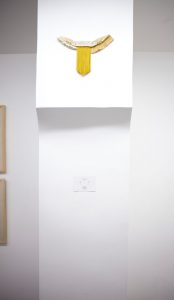Duo 2/5: Yolanda Tabanera & Pablo Milicua
In this second exhibition of the DÚO series we can see the work of Yolanda Tabanera and Pablo Milicua, artists living in Madrid.
In this exhibition you can see a careful selection of pieces made in recent years by both artists, in which the mixture and superposition of materials and objects is displayed, exhibiting their versatility when using plastic languages, while demonstrating a enormous formal coherence of its forms and speeches.
Baroque aesthetics and magic are present in both artists., who start from a visionary attitude that brings them closer to Brut Art and surrealism. With a long own history , Tabanera and Milicua are located in personal territories, far from the prevailing fashions and styles, but close to direct and recognizable modes of expression, seeking to create a work that is self-explanatory.
Yolanda Tabanera
Yolanda Tabanera was born in Madrid in 1965. She studied Literature and Fine Arts in Madrid and Munich, graduating in 1992 from the Kunstakademie in Munich.
Her work is strongly introspective, focused on the investigation of an interior space that, when is exteriorized,it becomes a very diverse and personal plastic language. The artist tackles topics such as the fragility and transcendence of the human body, its greatness and its mortality in a subtle and metaphorical way. In this process, it is essential to work with very different materials and connected with artisan techniques and processes from ceramics, esparto grass and glass to leather and goldsmithing. Tabanera explores the expressiveness and strength of these materials, endowing his objects with a unique life close to the aura of liturgical and ritual objects.
Since 1996, she has held individual exhibitions in galleries and museums, among others at the Eugenio Granell Foundation (Santiago de Compostela 2002), the Barjola Museum (Gijón 2006), Kunsthalle Bellevue Saal (Wiesbaden 2010), CEART (Fuenlabrada 2013), MAVA (Alcorcón 2014 ) and participates in numerous group exhibitions in places such as the Mori Museum (Tokyo 2006), Alcalá 31 room (Madrid 2007), Fundación Antonio Pérez (Cuenca 2009), Kunstverein Eislingen (2006) MIAM, Sète or in the exhibition Desesculturas, curated by Miguel Cereceda at the Círculo de Bellas Artes in Madrid and the Capa Foundation (Alicante 2002). Since 2003 she has exhibited with the Van de Loo gallery in Munich, and has been represented in Madrid by the galleries Utopia Parkway (1999–2004) Travesía Cuatro (2005–2009) and Fernando Latorre (2009-2014) with which she has held individual exhibitions and collectives and at fairs such as ARCO, ART COLOGNE, art KARLSRUHE and MACO. She carries out large-scale installations, some of them permanent, and interventions in places such as the Horno de la Ciudadela (Pamplona 2002), Maximiliansforum (Munich 2003), Círculo de Bellas Artes (Madrid 2004), Monastery of Santa María la Real (Nájera 2005 ), and Kunstakademie (Trier 2007).
Pablo Milicua was born in Bilbao in 1960. His first influences were Salvador Dalí, Pop art and comics. In his adolescence he created the Psychedelic Baroque Group with Wolfgang Arndt. He studied Fine Arts and graduated in the specialty of Painting.
At the end of 80’s his work acquired an objectual and sculptural character, which led to his mosaic and accumulation works. Milicua starts from a work of collecting significant materials that later rearranges into narrative structures using assembly and collage techniques in a process of destruction and creation, archeology and alchemy. He currently makes a long series of collages made from black and white photographs, drawn mainly from books from the 50s and 60s, which represent imaginary landscapes in an approach to the Flemish pictorial tradition of masters such as Bruegel, Bosch or Patinir.
Since 1983 he has participated in numerous exhibitions groups, and in 1985 he made his first solo show at the Windsor Kulturgintza gallery in Bilbao, which he has collaborated ever since. He paints the ceiling of the Gaueko nightclub,the a temple of afterpunk Basque.
He obtains awards and scholarships, such as the one offered by the Spanish Academy in Rome (1994-95). Between 1997 and 98 he directed the Casa Ubu exhibition hall in Vitoria, and curated the Mutantes del Paraíso exhibition for the Amárica room at the Museum of Fine Arts in this city. He makes outdoor montages and in abandoned buildings in Rome, Manchester, Arija and Brooklyn. He moved to Barcelona in 2003, where he came into contact with Fernando Latorre, in whose gallery in Madrid he exhibited regularly in the following years.Pablo Milicua holds cabinet exhibitions with a character installation and museum , as was seen in his exhibitions Amor al Arte (Alegría Gallery, Barcelona 2011), the ephemeral Museum of Bilbao (Windsor Kulturgintza 2011) The Reconstruction of Eden (Ava Art, Gijón 2013) or El Prodigi (Artur Ramón, Barcelona 2015). These exhibitions seek to recreate the curious fascination of the Wunderkammer with a visionary idea of art as an empire of wonder and prodigy.
Sponsored by:

Organiced by:


























